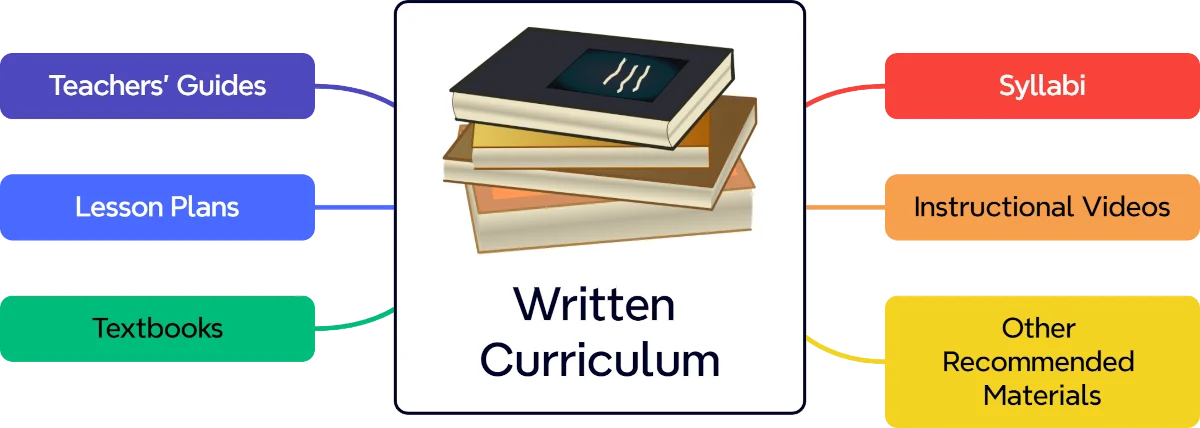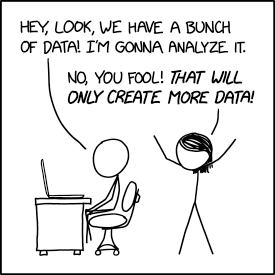Updated: 9/13/2025
What is the written curriculum? This article exhaustively explains what this type of curriculum is and provides some examples. Read on to find out.

Table of Contents
Introduction
The written curriculum is a crucial component of any educational program. It serves as a blueprint for teachers, providing them with a framework to guide their instruction and ensure consistency across classrooms.
A written curriculum is simply a set of teaching materials and plans that are documented and used by teachers. This can include teachers’ guides, instructional videos, textbooks, and other materials needed for teaching. These resources are provided by the school district or the individual school.
A written curriculum is simply a set of teaching materials and plans that are documented and used by teachers.
Objectives of the Written Curriculum
The objectives of the written curriculum are twofold: to outline the content and skills that students are expected to learn, and to provide a roadmap for teachers to follow in delivering that content. One of the primary goals of the written curriculum is to establish clear learning outcomes for students. By defining learning outcomes and guiding instruction, the written curriculum helps to promote student achievement and success.
By clearly defining what students should know and be able to do, the written curriculum helps to ensure that all students have access to a high-quality education. It also provides a basis for assessment, allowing teachers to measure student progress and identify areas where additional support may be needed.
In addition to setting learning goals, the written curriculum also serves as a guide for teachers in planning their instruction. It provides a structure for organizing content, sequencing lessons, and selecting appropriate instructional strategies. By providing teachers with a roadmap, the written curriculum helps to ensure that instruction is coherent and aligned with the intended learning outcomes.
Who develops the written curriculum?
The development of a written curriculum involves a collaborative effort from various stakeholders in the education system. These individuals play a crucial role in ensuring that the curriculum is comprehensive, relevant, and aligned with educational goals and standards.
One key group involved in preparing the written curriculum is subject matter experts. These experts possess in-depth knowledge and expertise in their respective fields, allowing them to identify the essential content and skills that students need to learn. Their expertise ensures that the curriculum reflects current research and best practices in the field.
Another important group involved in curriculum development is experienced educators. These individuals have firsthand experience in the classroom and understand the needs and challenges of students. Their input is invaluable in shaping the curriculum to meet the diverse learning needs of students and to ensure its practicality and effectiveness in the classroom.
Additionally, curriculum developers and instructional designers play a crucial role in translating the expertise of subject matter experts and educators into a coherent and structured curriculum. They have the skills to organize and sequence the content, develop appropriate assessments, and design instructional materials that support effective teaching and learning.
The level of experience and expertise required to prepare the written curriculum varies depending on the complexity and scope of the curriculum. Subject matter experts should have advanced knowledge and experience in their field, while educators and curriculum developers should have a strong understanding of pedagogy and instructional design principles.
Examples of the written curriculum
Examples of the written curriculum can be found in various fields, including science, social science, engineering, medicine, and law. These examples provide a glimpse into how the curriculum is structured and what content is covered in each field.
Science
In the field of science, the written curriculum may include topics such as biology, chemistry, physics, and environmental science. It outlines the key concepts, theories, and experiments that students need to learn in order to develop a strong foundation in scientific knowledge.
Specific example topics for different subjects include the following:
- Biology: Cell structure and function, genetics, evolution, ecology, laboratory methods in microscopy and dissection.
- Chemistry: Atomic structure, periodic table trends, chemical bonding, stoichiometry, thermodynamics, lab experiments in titration and synthesis.
- Physics: Laws of motion, energy and work, electricity and magnetism, waves and optics, experiments with pendulums and circuits.
- Environmental Science: Climate change, biodiversity, resource management, environmental policies, fieldwork in ecosystems assessment.
Example written curriculum document: “General Biology 101 Syllabus” with weekly topics, required readings, lab schedules, and assessment methods.
Social Science
In social science, the written curriculum may cover subjects like history, geography, economics, and sociology. It provides a framework for understanding the social, cultural, and economic aspects of human society, and helps students develop critical thinking and analytical skills.
Specific example topics for different subjects include the following:
- History: Ancient civilizations, colonialism, revolutions, world wars, contemporary global history.
- Geography: Physical geography (landforms, climate), human geography (population, urbanization), GIS mapping.
- Economics: Microeconomics (supply & demand, markets), macroeconomics (GDP, inflation, fiscal policy), development economics.
- Sociology: Social institutions, culture, social inequality, research methods (surveys, ethnography).
Example written curriculum document: “Introduction to Sociology Syllabus” specifying required texts, topics like “Social Stratification” in Week 5, and assignments such as “Case Study on Urban Poverty.”
Engineering
In engineering, the written curriculum focuses on subjects like mathematics, physics, computer science, and various engineering disciplines. It provides a comprehensive understanding of engineering principles, problem-solving techniques, and design processes.
Specific example topics for different subjects include the following:
- Mathematics for Engineers: Calculus, linear algebra, differential equations.
- Computer Science: Algorithms, data structures, programming (Python, C++).
- Core Engineering: Thermodynamics (mechanical engineering), Circuit Analysis (electrical engineering), Structural Mechanics (civil engineering).
- Design Projects: Capstone design course with a written outline of milestones, prototyping, and final presentation.
Example written curriculum document: “Civil Engineering Curriculum Map” detailing a 4-year sequence, e.g., Year 1: Calculus I & Physics I, Year 3: Structural Analysis, Year 4: Capstone Project.
Medicine
In the field of medicine, the written curriculum encompasses subjects such as anatomy, physiology, pharmacology, and clinical skills. It guides medical students through the knowledge and skills necessary to diagnose and treat patients effectively.
Specific example topics for different subjects include the following:
- Anatomy: Human body structure, dissection lab manuals.
- Physiology: Functions of major organ systems (respiratory, cardiovascular).
- Pharmacology: Drug classifications, mechanisms of action, clinical applications.
- Clinical Skills: Patient history-taking, physical examination techniques, medical ethics.
Example written curriculum document: “Doctor of Medicine Year 2 Curriculum Guide,” listing modules like “Cardiovascular System: Anatomy, Physiology, Pharmacology,” with associated lab and clinical rotations.
Law
In law, the written curriculum includes subjects like constitutional law, criminal law, contract law, and legal research and writing. It provides a foundation in legal principles, case analysis, and legal reasoning.
Specific example topics for different subjects include the following:
- Constitutional Law: Separation of powers, bill of rights, judicial review.
- Criminal Law: Elements of crimes, defenses, criminal procedure.
- Contract Law: Formation of contracts, breach, remedies.
- Legal Research & Writing: Case briefing, legal citation, drafting memoranda.
Example written curriculum document: “First-Year Law Curriculum Handbook,” requiring core subjects: Constitutional Law I, Criminal Law I, Legal Method & Writing.
These examples show that the written curriculum is not just a list of topics but often takes the form of syllabi, program outlines, course descriptions, and curricular maps that specify content, sequencing, methods, and assessment criteria.
These examples demonstrate the diverse range of subjects and content covered in the written curriculum across different fields. They highlight the importance of a well-designed curriculum in providing students with the knowledge and skills they need to succeed in their chosen field.
How the written curriculum gets tested: 4 Steps
Once the written curriculum has been developed, it undergoes a rigorous testing process to ensure its effectiveness and alignment with educational goals. The testing process involves several steps that help evaluate the curriculum’s content, structure, and instructional strategies.
Step 1 Gather the experts
The first step in testing the written curriculum is to gather a diverse group of experts in the field. These experts review the curriculum and provide feedback on its clarity, coherence, and relevance to the intended learning outcomes. Their expertise ensures that the curriculum meets the standards and requirements of the specific field.
Step 2 Pilot testing
The curriculum is pilot tested in a small-scale setting. This involves implementing the curriculum in a select group of classrooms or educational institutions. During this phase, teachers and students provide feedback on the curriculum’s usability, engagement, and effectiveness in facilitating learning. This feedback helps identify any areas that need improvement or modification.
Step 3 Thorough revision
After the pilot testing, the curriculum undergoes a thorough revision based on the feedback received. This includes refining the content, adjusting the instructional strategies, and addressing any identified gaps or weaknesses. The revised curriculum is then ready for further testing.
Step 4 Large-scale implementation
The final step in testing the written curriculum is a large-scale implementation. This involves implementing the curriculum in a wider range of classrooms or educational institutions.
The curriculum’s impact on student learning outcomes is assessed through various measures, such as standardized tests, performance assessments, and student feedback. This data is analyzed to determine the curriculum’s effectiveness and its alignment with the desired educational goals.

By following this step-by-step testing procedure, educators can ensure that the written curriculum is well-designed, effective, and capable of providing students with the knowledge and skills they need to succeed in their academic and professional pursuits.
Evaluation of effectiveness of the written curriculum
The effectiveness of a written curriculum is measured through a comprehensive evaluation process that assesses its impact on student learning and achievement. Several indicators are used to determine the effectiveness of the curriculum and its alignment with educational goals.
1. Quantitative Approach: Student Performance
One key indicator is student performance. Standardized tests and performance assessments are used to measure students’ knowledge and skills acquired through the curriculum. These assessments provide quantitative data that can be compared to established benchmarks or standards.
2. Qualitative Measures
Additionally, qualitative measures such as portfolios, projects, and presentations can provide a more holistic view of student learning.
3. Feedback
Another indicator is teacher feedback. Teachers play a crucial role in implementing the curriculum and observing its impact on student learning. Their insights and observations can provide valuable information about the curriculum’s effectiveness in engaging students, addressing their diverse needs, and promoting critical thinking and problem-solving skills.
Additionally, student feedback is an important indicator of the curriculum’s effectiveness. Surveys, interviews, and focus groups can gather students’ perspectives on their learning experiences, their understanding of the content, and their overall satisfaction with the curriculum.
4. Alignment with Educational Standards and Objectives
Furthermore, the curriculum’s alignment with educational standards and objectives is assessed. Experts review the curriculum to ensure that it covers the necessary content, skills, and concepts outlined in the curriculum standards. This alignment ensures that the curriculum is preparing students for future academic and professional success.
By evaluating the effectiveness of the written curriculum through these indicators, educators can make informed decisions about its strengths and areas for improvement. This ongoing evaluation process ensures that the curriculum remains relevant, engaging, and effective in meeting the needs of students and achieving educational goals.
Summary and Conclusion
The previous sections have explored the development, examples, testing, and evaluation of a written curriculum. Throughout this discussion, it has become evident that the written curriculum plays a crucial role in education.
Firstly, the written curriculum serves as a roadmap for educators, providing them with a clear framework for instruction. It outlines the content, skills, and concepts that students should learn, ensuring consistency and coherence in the educational experience. This ensures that all students have access to a high-quality education, regardless of their background or location.
Secondly, the written curriculum guides the assessment process, allowing educators to measure student learning and progress. By aligning assessments with the curriculum, educators can accurately gauge students’ understanding and identify areas for improvement.
This data-driven approach helps to inform instructional decisions and tailor teaching strategies to meet the diverse needs of students.
Furthermore, the written curriculum promotes accountability and transparency in education. It provides a standard against which educational institutions and systems can be evaluated.
By developing, implementing, and evaluating a well-designed written curriculum, educators can ensure that students receive a high-quality education that prepares them for future success.
Cite as:
Alvior, M. (2023, November 20). Development and examples of the written curriculum. SimplyeducateMe. https://simplyeducate.me/2023/11/20/written-curriculum/


